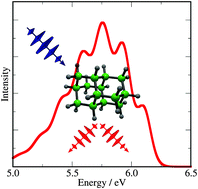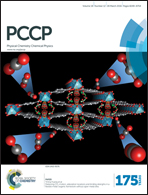Vibrationally resolved optical spectra and ultrafast electronic relaxation dynamics of diamantane
Abstract
We present theoretical simulations of the vibrationally resolved photoabsorption and photoemission spectra of diamantane combined with nonadiabatic dynamics simulations in order to identify the state responsible for the measured photoluminescence of diamantane and to determine the mechanism and the time-scales of the electronic state relaxation. Diamantane is a prototype representative of the diamondoid class of hydrocarbons which have recently gained significant interest due to their unique electronic properties. This molecule is characterised by an almost dark first excited state, which therefore cannot be directly excited. Moreover, the calculated vertical transition from the geometrically relaxed first excited state to the ground state also bears no intensity. However, recent experiments suggest that the observed photoluminescence originates from the lowest excited state. We have performed spectral simulations in the frame of the Herzberg–Teller approximation for vibronic transitions, which goes beyond the Franck–Condon approximation of constant transition dipole moments and takes into account their linear dependence on the geometrical deformations. In this way, the available experimental spectrum could be fully reproduced, resolving the issue about the origin of the photoluminescence. Moreover, the photoemission from the first excited state also implies that ultrafast nonradiative processes have to take place after the initial excitation of the bright electronic states. We have determined the mechanism and time-scales of these relaxation processes by performing nonadiabatic dynamics simulations in the manifold of s- and p-type Rydberg excited states. The simulations demonstrate that the lowest excited electronic state of diamantane gains significant population from higher-lying states already after several hundreds of femtoseconds. Thus, our dynamics simulations combined with spectra calculated using the Herzberg–Teller approximation allow us to fully explain the observed photoabsorption and photoemission properties of diamantane.


 Please wait while we load your content...
Please wait while we load your content...